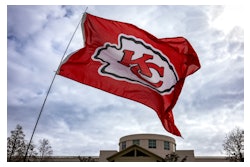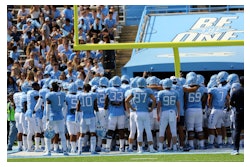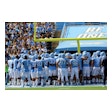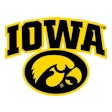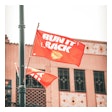Securing a spot on an NBA roster is tougher than ever, but thanks to developmental and international leagues, options for professional-caliber basketball players abound
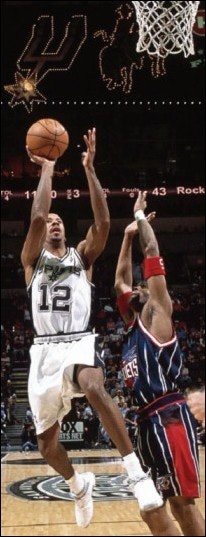
As a 29-year-old NBA rookie last season, Houston Rockets guard/forward Juaquin Hawkins was lucky to even be playing in the league. His long and winding road to the pros began in 1996 upon graduation from Long Beach State University, where he was a three-time Big West Conference Defensive Player of the Year, and included stints in the training camps of the Los Angeles Lakers and Los Angeles Clippers. Then it was on to international play in Taiwan, Japan, the Philippines and China before he found temporary homes in the Continental Basketball Association, the United States Basketball League and the upstart ABA2000. Hawkins even played briefly for the Harlem Globetrotters. Even though he only averaged 2.3 points per game last season for Houston, the Rockets thought enough of Hawkins to send him to the Southern California Summer Pro League, one of four regional training grounds for typically younger NBA players and draft choices. His future, though promising, still hangs in the balance.
By comparison, Nate Driggers, the 1994-95 NAIA Player of the Year at the University of Montevallo, spent time as an undrafted free agent in rookie camps with the Milwaukee Bucks and the Minnesota Timberwolves, as well as in the Denver Nuggets training camp. He later bounced around the CBA and the now-defunct International Basketball Association. An offer to play ball in Spain was on the table when the Boston Celtics took a chance on him, making Driggers (in 1996-97) the first player to climb from the IBA to the NBA in less than a year. Four weeks later, Boston waived him, and now Driggers appears to be out of professional basketball.
Unless you're LeBron James - the highly touted 18year-old who was the top pick in the NBA's 2003 draft - few things in the world of professional basketball are guaranteed. Hawkins and Driggers are living proof of that. "Having LeBron go No. 1 in the draft was the worst thing that could have happened," says Michael Garnes, a player agent for 14 years and president/founder of Next Level Sports in St. Augustine, Fla., which operates MyShot.net, an Internet marketing tool for basketball players all over the world. "Now every kid who can play is going to drop his books and think he's next. But look at how long it took for someone like LeBron James to come along."
Consider this: The NBA only has room for about 400 players; the WNBA, roughly 200 players. That leaves about 30,000 men and women players coming out of U.S. colleges every year to either toil in obscurity or find another career. For those who choose the former, several organizations - commonly called developmental leagues but essentially farm systems for the NBA and the WNBA - simmer with untapped talent, tempting players with such slogans as "The League of Opportunity" and "The NBA Dream Starts Here."
"The dream can start anywhere," Garnes says. "You don't go to one league first, then to another. Someone can discover you on a playground somewhere and give you a chance. The NBA doesn't have a system in place to make it."
Unlike, say, pro baseball (or, to a lesser degree, pro football and pro hockey), the NBA offers no hierarchical structure to guide players through the ranks. "Everybody's in the same boat, trying to catch the eye of a scout," says Milt Newton, director of player personnel for the National Basketball Development League, an initiative the NBA began two years ago as a means of preparing both talented players and administrators for a possible career in the NBA. In its two seasons, the NBDL has sent 18 players to the promised land. "Maybe five or 10 years from now, the NBA will have a structure like Major League Baseball, where each team has a farm system and can shuffle players up and down," Newton says. "But right now, a developing player could use us or he could use one of the other minor leagues."
There are plenty of minor leagues from which to choose, and they welcome hundreds of talented players on their way up (and down) every year. Most of the leagues follow strict NBA game rules, but none of them pay anywhere near the NBA's minimum salary.
In addition to the NBDL, there is the USBL, which plays its seasons in the summer, and the CBA, which continues its recovery after former NBA all-star and current Indiana Pacers head coach Isiah Thomas purchased the league in 1999 and proceeded to lead it into bankruptcy, forcing a premature end to the 2000-01 season. The fledgling American Basketball Association, formerly known as the ABA2000, is expected to return this November after taking the 2002-03 season off to restructure. Also struggling but reportedly steadfast is the American Basketball League (formerly the American Pro Basketball League, formerly the United Pro Basketball League, formerly Pro Basketball USA) and the Eastern Basketball Alliance, a small league recovering from local team-marketing disasters.
The NBA says its teams have scouts at all NBDL, CBA and USBL games, while some may even send scouts to games in other leagues. In addition, at least one of the NBA's pro summer leagues offered a weeklong Super Camp this year for hungry players looking for an in with any professional league. Scouts from the NBA, NBDL, USBL, CBA and many international leagues attended the sessions in search of new talent.
For female players, there is the National Women's Basketball League, which began play in 1997 with seasons that preface the WNBA's summer schedule. Unlike the NBDL's relationship with the NBA, however, the NWBL is not affiliated with the WNBA.
There used to be even more opportunities for players, as many North American-based leagues have come and gone in recent years. The International Basketball League suspended operations in 2001, the same year the International Basketball Association folded after six seasons. Both floundering leagues had been involved in ill-fated merger attempts with the CBA. Meanwhile, the X-Treme Basketball Association appears to have vanished after a 2002 startup, as have the Southwest Basketball League (founded in 1997) and its offshoot, the Women's Southwest Basketball League. Also on the women's side, the American Basketball League folded after two seasons of going head to head with the NBA-funded WNBA. There was even an organization, the World Basketball League, specifically for players shorter than 6 feet, 5 inches (later 6 feet, 7 inches). It disbanded in 1992. (The fate of other recently active organizations, such as the Canadian National Basketball League, the National Rookie League, the American Basketball Alliance and the Women's American Basketball Association are unknown.)
Yet recurring league failures don't appear to have diminished players' and owners' enthusiasm or optimism. They just find somewhere else to take their game. "The vast majority of these players think they can make it to the NBA," says Gary Hunter, commissioner of the CBA, which had 73 former league players on 2002-03 NBA training camp rosters. "We have eight teams with 10 players each. If eight players get called up during the season, that's 10 percent, and that isn't bad. If a player has a one-in-10 shot of playing in the NBA, that's going to keep him going."
Some players, citing more money and better opportunities, take their shots overseas, where U.S. citizens often play on teams that - depending on the country - place a huge amount of pressure to win on Americans and reward them with seven-figure (often tax-free) salaries.
It's no wonder that an agent who has, say, 100 clients with either NBA or WNBA potential will likely suggest 100 different ways for those players to follow their hoop dreams. "The search for talent is exhaustive and never-ending," says Matt Bourne, the NBA's director of public relations. "Our teams are free to go out and get any player who is eligible from anywhere."
Adds Dennis Truax, a spokesman for the USBL, "If you can play, if you can help your team win and put people in the stands, we don't care where you come from."
For almost 25 years, the CBA was known as "the official developmental league of the NBA," receiving capital from the NBA to develop players, coaches and referees. That distinction ended during the Thomas era and the subsequent evolution of the NBDL, or the "D League," as it's often referred to in the business. But the CBA is still the oldest and longest-running pro basketball league in the world, beginning its first season back in 1945 - one year before the NBA started up. Current NBA players Raja Bell, Anthony Mason and Mark Pope passed through the CBA's ranks, as did longtime NBA coaches George Karl and Phil Jackson.
"We would have merged with the NBDL last year or this year, but we just weren't able to arrive at mutually satisfactory terms," says Hunter, who has served as the CBA's commissioner in both the pre- and post-Thomas eras. "It makes sense for us to be under one umbrella, because you could have interleague play and you could strengthen the brand."
On paper, the merger would have made sense. Both the 2002-03 season, 10 NBDL players got the call (sometimes, more than once) by NBA teams as midseason replacements, while six players in the CBA were chosen by NBA teams. Both leagues have even shared personnel. Phil Evans, who Hunter once hired as the CBA's deputy commissioner and general counsel, is now NBDL president.
Most of the NBDL's teams are located in the Southeast, while the CBA focuses its concentration in America's heartland. "Right now, there might be some competition for players as the season begins," Hunter says. "But we are not really in competition with the NBDL, because our efforts are in different locations."
Other differences between the two leagues are vast. The NBA, for example, owns all NBDL franchises, although plans eventually call for a shift toward local ownership. That's how the CBA operates all of its teams. While teams in both leagues play in small or midsize markets in family-friendly venues, the NBDL has a contract with ESPN; the CBA receives little television coverage. The D League pays its players, who must be at least 20 years old, between $12,000 and $28,000 a season, while CBA players can be of any age and earn a comparable $500 to $1,500 a week.
On the other hand, eight-team attendance totals for the CBA's 2002-03 season significantly eclipsed those of the NBDL's eight-team totals. CBA teams drew 494,830 fans, with a per-game average of 2,577. Attendance in the NBDL trailed at 345,519, with a per-game average of 1,664.
During the NBDL and CBA off-seasons, the USBL kicks into action, having sent 137 players to the NBA since its debut in 1985. Last season, 29 players on NBA rosters had USBL experience. But league officials say they've never been approached by the NBA to discuss teaming with the NBDL, probably because of the USBL's April-to-June schedule, which allows players to bounce back and forth between any of that league's 11 teams and either the CBA or the D League. "We're really the only league other than the NBA going on at that time," Truax says. "We're not comparing ourselves to the NBA by any means, but we've carved our niche. We have given American players another place to play in the United States, as opposed to overseas."
USBL teams are privately owned and concentrated along the East Coast and in the Midwest, and they play in venues similar to the ones serving teams in the NBDL and CBA. Total attendance for the 2003 season was 175,905, with a per-game average of 1,303. Player salaries hover around $400 to $500 a week. The USBL hopes to expand to as many as 14 teams for the 2004 season.
Following a slightly different business model than most of its minor-league peers is the EBA, which is moving away from local ownership to majority league ownership but with local minority stakeholders. Players on the league's seven mid-Atlantic teams earn about $150 per season and usually play in high school or junior-college gymnasiums.
The EBA has been around in one form or another since at least the 1970s, and it was actually once part of the old CBA. More recently, the league has been a steppingstone for a handful of players on their way to the NBA. It's also a place to help former college standouts stay on top of their game. "There are a lot of great basketball players out there who don't make the NBA," says Dick Anzolut, president of the EBA. "Some of them say, 'To hell with it, I'm going to start my life.' Then there are those who want to keep playing ball. They are the ones who find their way to our league. It's a place for people who love to play competitive basketball but don't want to give up their career outside of basketball."
Last year, the EBA created the Women's EBA, which has counterpart female teams to the men's franchises in four of the league's seven markets. "If the women's team draws 50 people at $8 apiece, that's $400. At our level, $400 is a lot," Anzolut says. One of that league's players, Leigh Aziz, is now a rookie forward signed as a free agent in May by the WNBA's Indiana Fever.
Aziz's success - and that of the Women's EBA, which doesn't pay its players - is especially noteworthy. The only women's developmental league that seems to be active outside of the Women's EBA is the six-team NWBL, and those players actually pay the league to participate. Occasionally, one will get called up to the WNBA. But unlike the various men's leagues, says WNBA spokesman John Maxwell, "the NWBL or any other women's league does not serve as a pipeline to the WNBA."
That leaves the overseas market. While developmental basketball is thriving in the United States (at least for male players), many other countries also offer solid playing opportunities. Scores of international leagues boast competitive teams with players who can hold their own on a world stage. For proof, one need only recall the sixth-place finish posted by a team of NBA all-stars at the 2002 FIBA World Basketball Championships. Or just look at the 2003 NBA draft, which produced a record 21 international picks - nine in the first round alone.
While overseas markets have their own homegrown talent, the American players - "the imports," as they're sometimes called - typically dominate international play. "When your team wins a game over there, they say it's usually because of the American," says Newton, who was cut by the Los Angeles Lakers as a free agent after graduating from the University of Kansas in 1989. He spent a year in the CBA before making the roster of an Australian team in 1991. "And when your team loses a game, all eyes are on you, too," he continues. "Win or lose, you're the guy. If you score 40 points but the team loses a lot of games, you'll be the one everyone wants to get rid of."
Indeed, the pressures are great. But then, so are the salaries. Teams in France, Spain and Turkey have been known to dole out million-dollar annual salaries. "A lot of the guys who got drafted by the NBA this year are going to wind up playing overseas for six figures," Garnes says. "The income is tax-free, there's less competition than in the NBA, and the seasons are shorter."
The differences don't stop there. Most leagues outside of North America pay their players in cash or have the money wired directly to a player's bank account. The sport is not taken as seriously in some countries as it is in the United States, either, as players have been known to saunter into the locker room before practice with a cigarette dangling from their lips. Some teams play in sparkling gyms and work out in weight rooms comparable to those of any NCAA Division I team, while others play in rundown facilities with linoleum floors or hardwood rife with dead spots.
In countries such as Italy and Spain, games are festive events, while games in other countries will be lucky to draw 100 spectators. "If you're playing women's basketball in Switzerland, you might be in an empty gym," Garnes says.
"Sometimes players develop a really good career plan overseas," Newton says. "I didn't see myself getting to the NBA that way. I wasn't too enamored with playing overseas for years and years."
Not everybody is, which is why so many new minor leagues have come and gone during the past several decades. Only a few hang on for as long as the CBA and the USBL, and one or two even come back after a season or more away. The return of the "new" ABA this fall with at least six teams scattered throughout the United States and Mexico will create even more opportunities for players. As the ABA2000, the league played two seasons between 2000 and 2002 in the hopes of revitalizing the old ABA spirit of the 1960s and '70s. (Think red-white-and-blue game balls and such colorful stars as "Dr. J" and George "Iceman" Gervin.) Plans are now under way for an ABA Players Association and an ABA University to train franchise owners, says Jim Clark, the ABA's chief executive officer.
Representatives of pro basketball's other minor leagues welcome the return of the ABA. "Could there be the potential of losing one, two, maybe three players to the NBDL or the ABA. Sure," says the CBA's Hunter. "But when you've got some of the best players out there, only the talent scouts are going to be able to tell the difference. Finding talented coaches and players really isn't a problem."
Newton agrees. "People tend to say the talent pool is going to get diluted," he says. "The way I look at, our league can only have so many players. We're all in the same business, and that is the development of grassroots basketball. Of course, we have to put ourselves in situations in which we're taking players that NBA teams are interested in. So we can't take just any player. But it's all give and take. If I lose out on one player, I just get somebody else. I don't think we've ever had a situation where we said, 'We've got to have this specific player.' "
Despite a seemingly overabundance of talent, the hoop dreams of individual players still die hard. "We get guys in their 30s who are five-, six-, seven-, eight-year veterans of the CBA and still think they'll make it to the NBA," Hunter says. "There are enough success stories in pro basketball to keep the dream alive."














